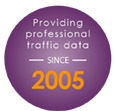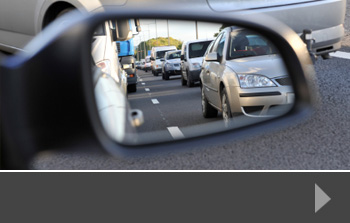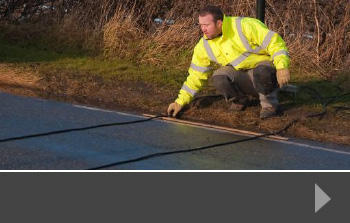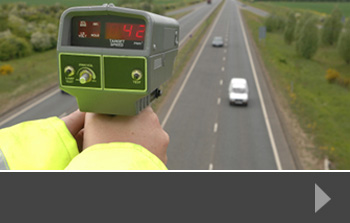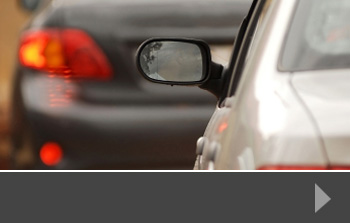The busiest day on the roads this Christmas…
With millions of us travelling to see friends and family over the festive season, the UK’s road networks can be filled to capacity on one or two key dates over the holidays. The dates change each year, depending on when Christmas Day falls, so transport planners and road users alike need to plan well ahead.
Friday December 21st
According to a survey by the AA of around 20,000, most people are planning to travel on Friday December 21st. For many people, this will be the last day in the office; the kids have broken up from school, and everyone is hitting the roads to get to their families for a full weekend ahead of Christmas. So, what does that mean for the road network?
Congestion
Nearly 60% of those surveyed said they would be on the roads on the 21st, which means the network has to cope with far more traffic than usual – even for a Friday. Drivers should expect their journeys to take longer than usual and be prepared to sit in traffic jams. There are several areas on high-traffic motorways where roadworks are still in progress, with 50 mph restrictions and these are likely to be high points of congestion.
What to do
- Do you really have to travel on Friday? If you do, can you leave earlier to avoid the later traffic caused by people finishing work early or travelling straight from the school pick-up? Would it matter if you left early on Saturday morning instead of on Friday afternoon? For longer journeys, setting off early in the morning can take a lot of the hassle out of the journey, and still get you to your destination at a reasonable time.
- Check current traffic conditions before you leave. Google Maps has a function where you can say what time you’d like to arrive at your destination, and it tells you when you might leave in order to get there on time.
- Make sure that, as well as the Christmas presents, the food, the wrapping paper, the booze and the overnight bags, you pack anything you might need in the event of a breakdown. Join a breakdown service or, if you’re already a member, make sure you have your membership card with you.
- If there is something wrong with you vehicle on the motorway, try to take the next exit off the motorway, or go into a services area if that’s closer. If you can’t do that, pull over onto the hard shoulder, put your hazard lights on and get out of the vehicle – preferably by the doors closest to the embankment. Call your breakdown service – you can do this from your mobile phone or from one of the emergency phones on the side of the motorway.
About Road Data Services
Road Data Services is a traffic and pedestrian data specialist. We conduct a range of bespoke traffic surveys, journey time data collection, parking and pedestrian surveys, providing data to a range of decision makers including developers and local planners. Our data helps to inform decisions that involve changes to the existing road network, or the design, construction and use of new roads. For more information about how we can help with your next project, contact us today.
If, like most people, you’ve sat in your car in a traffic jam wondering why the gas repairs are being done at the same time as the new development building, you’ll be encouraged by the knowledge that planners and transportation leaders are working hard to determine how to streamline new projects and improvements to existing infrastructure to help keep things moving.
This type of work is data driven – that data might come from traffic surveys and on-site data collection or it might come from historic reports, or from working alongside other providers such as the rail network or local utility companies.
Inrix, a leading traffic information supplier, says that its data shows that traffic congestion in the UK costed more than £37 billion in 2017 with, on average, 31 hours per year spent in congestion per driver. That’s a huge dent in the economy – both nationally and regionally.
Understanding traffic data
Underpinning improvements in this area is all about taking the time to understand what happens on our roads on a day-to-day basis, and how that activity is affected by roadworks, improvements and development work. That means looking at the knock-on effects as well as the immediate impact. When considerable works are in place, the journey time from A to B using that route will be increased. To know what the increase might be, you need a bench measure for that journey, hence the journey survey.
Planners and project managers also need to take into account the potential for routes around the area to become more congested as drivers try to avoid the works. That means either creating a good diversion route, or knowing what the key alternative routes might be, and ensuring there are no works or blockages on those routes whilst the major work is taking place. By communicating and co-ordinating, agencies can help each other to minimise the impact of works on road users.
Road traffic surveys from RDS
At RDS, we offer a wide range of detailed surveys to help transport, planning and project professionals understand the potential impact of work in a given area. Whether it’s for long-term roadworks or improvements, or for planning a new road system to serve a residential or commercial development, it’s important to understand the current state of play in terms of journey time, congestion, parking and pedestrian usage.
We offer comprehensive surveys with accurate data supplied in the format that’s best for you. To find out more about how we can help, contact us today.
As a company that specialises in pedestrian surveys – looking for ways to make places safer for all the people who use them – we were interested to see a recent statement by the Department for Transport.
The statement said that the government is planning to review the current Highway Code, in order to update guidance on how to make sure pedestrians and cyclists are safer when using the road system. The review is part of the government’s drive to reduce the fatality rate amongst this group of road users.
In particular, the review will give new and clearer guidance on the issue of ‘close passing’, to help drivers be aware of how wide a berth they should ideally give to cyclists and pedestrians. Many accidents are caused when vehicles pass too closely, either making contact with the cyclist or pedestrian, or unnerving them so that they lose control and fall into the path of the vehicle. The review will also look at the issue of people opening vehicle doors into the road without checking whether there is a cyclist approaching.
Focus on pedestrian health and safety
The Cycling and Walking Minister, Jess e Norman said: “Britain has some of the safest roads in the world, but we need them to be safer still for all – and particularly for cyclists, pedestrians and other vulnerable road users. Cycling and walking are increasingly being understood as crucial parts of an integrated approach to issues of health, obesity, air quality and town and city planning. But this will only happen if people feel safe on the roads. These measures are part of a steady process of improvement and reform designed to achieve just that.”
The Department for Transport has also announced a new national guide for safe cycling, and said that Highways England has agreed a £3m contract with Sustrans to deliver improvements to the National Cycle Network.
The impact of pedestrian surveys
It’s easy for pedestrians to be ignored when it comes to network improvements, or indeed new developments. And yet, providing safe, accessible and attractive pedestrian areas, along with clear crossings, traffic calming and other infrastructure can completely transform not just the look and feel of the area, but the safety of all those using it.
At RDS, we work with a wide range of clients to encourage pedestrian and non-motorised access to towns, cities and new developments. To find out more, contact us today.
Earlier this month, the Department of Transport (DoT) announced that it will invest £10 million to create a new app showing real-time traffic congestion across the UK. The new technology, which will be called Street Manager, will be made available to companies and app developers free of charge.
The DoT wants to help drivers combat traffic congestion and reduce the hours often wasted sitting in traffic jams, which can have a knock-on effect on the wider economy. The government is also concerned about roadworks – especially those for utility purposes – that cause congestion at peak travelling times, and have already given local authorities the power to fine utility companies up to £2,500 per day for interrupting traffic flow. These fines, it hopes, will also encourage local authorities to ask utility companies to liaise with each other so that work can be carried out at the same time, leading to fewer disruptions.
Collaborating with other traffic apps
The Street Manager system will replace the government’s current technology, which often has out-of-date information about roadworks and speed restrictions. The government is hopeful that popular route-mapping systems like Google Maps and Waze will use Street Manager to update their own apps with details of roadworks, helping users to plan journey more easily and spend less time stuck in traffic.
It’s estimated that UK drivers waste more than 30 hours in traffic jams every year. That’s frustrating for the average driver, but for those businesses that rely on the road network in order to make deliveries, transport goods, or provide services, it can mean a hit to the bottom line.
Neither government nor local councils want to see an increase in traffic – aside from the fact that it discourages people to travel to and around local places, standing traffic also contributes to air pollution and damage to the environment.
Local traffic surveys from RDS
Data on current traffic conditions can be collected in a variety of ways. A change in the road layout, a new development or long-term roadworks or road closures can all contribute to local traffic congestion problems. To plan ahead for these situations, commission a traffic survey – the data we provide at RDS is accurate, timely and useful in the decision-making process. We can tailor our surveys to your precise requirements and supply the data in whatever format is best for you.
To find out more about how we can help, contact us today.
Earlier this month, the Transport Select Committee launched an inquiry into the funding and governance of local roads in England. This is an acknowledgement of the considerable amount of traffic carried by the local network and the relative lack of funding and upgrading when compared to the main motorway network.
In fact, local roads make up 98% of England’s road network – which totals about 245,000 miles of road – and they carry the majority of traffic. Whilst the government has been keen to sort out the motorway network, with a variety of extension and upgrade programmes, local roads tend to be the responsibility of local authorities and so maintenance and upgrade varies across the network.
What is the Committee is looking for?
The Transport Select Committee wants to get a clear picture of the current state of local roads across England and the approach to funding and maintenance. In particular, they want to see written evidence about:
- The condition of local roads in England and how they have fared over time, particularly compared with other parts of England’s road network;
- The direct and wider economic and social costs of not maintaining local roads;
- The quality of monitoring and reporting of local road conditions;
- Whether the current approach to maintenance of local roads is appropriate and whether it needs to be improved;
- The suitability of governance structures for maintaining local roads and whether any changes are required;
- The funding requirements of local roads and the suitability of current funding streams for the immediate and longer-term future;
- Whether there is a role for alternative funding models for local roads maintenance and investment; and
- The regional distribution of local roads funding across England.Professional traffic surveys give an accurate picture of local road use, including areas that are regularly congested, and roads that are often used as shortcuts or ‘rat-runs’. Our local traffic surveys are often used to inform decisions about re-routing, upgrading or introducing traffic-calming measures and can go hand-in-hand with plans for new residential, commercial or retail developments. They provide excellent, up-to-date data about the ways particular roads and routes are used.To find out more about our traffic, journey time, Automatic count and other dedicated surveys, contact us today.
- The Transport Select Committee’s inquiry is taking evidence until October 2nd, and anyone who wants to contribute can put their evidence in writing and submit it via the Committee’s website.
- How can traffic survey data help?
A conference planned for November this year will look at Intelligent Transport Systems (ITS) and how they can be used across the transport network to create sustainable and long-term travel plans for the UK. This presents a great opportunity for those businesses and specialists – like RDS with its traffic survey expertise – to see how technology might be utilised to improve transport in the future.
Dealing with congestion
One of the biggest issues on our road network – whether on motorways or in towns and cities – is congestion. We are often asked to conduct traffic surveys, journey time research and parking surveys to see where improvements can be made – particularly when new developments are planned.
The conference, called The ITS (UK) Summit 2018 is taking place in Bristol and is sponsored by Bristol City Council and will cover topics including:
- Dealing with congestion
- Funding
- Transport policy and procurement
- Breaking the barriers to delivery
- Mobility as a service
- Preparing the network for connected and autonomous vehicles
- Making better use of road space
Delegates will be mostly drawn from ITS (UK) membership which comprises over 150 organisations including government departments, consultants, local authorities, academic institutions and manufacturing companies.
Speaking about the conference, the ITS (UK) general secretary, Jennie Martin said: ‘This is not just another conference; this is a meeting of the finest minds in highways and transport as well as ITS, to discuss and examine the issues around implementing the great technology we have … I can promise this event will be like no other and really underlines our role as the voice of transport technology in the UK.’
RDS and technology
At Road Data Services, we use the latest technology to undertake a range of traffic, parking and pedestrian surveys. Our data collection gives clients the information they need in order to make informed decisions, alter plans, prepare for additional traffic or allocate additional space for sustainable parking. Our Automatic Traffic Count surveys collect detailed traffic data, including classification and speed on a vehicle-by-vehicle basis, and we use sophisticated technology to ensure the accuracy of the information we collect.
To find out more about our traffic surveys, Automatic Traffic Count services, ANPR and Bluetooth surveys and more, just contact us today for a chat about your next project.
At a time when local authorities are under pressure to approve new housing developments, it’s important to reflect on the other changes needed to cope with additional populations in already-busy areas. Key to this is understanding the pressure on local infrastructure, like the road network, and this is something that a detailed traffic survey can help with.
Stagecoach highlights the problem
Recently, Stagecoach North East wrote a strongly-worded letter to elected local politicians in the Tees Valley area, pointing out its concerns about the impact of congestion on its bus drivers and passengers as a result of what it perceives as poor infrastructure planning. The letter suggested that it costs Stagecoach North East £1m per year to put on extra services to try and keep services on time, saying that average bus speeds have fallen by 4% in the past four years.
Where new developments are approved and built, but no significant improvements are made to the road system, congestion is bound to increase. This not only has a significant effect on average journey times; it reduces air quality and increases the likelihood of accidents.
Keeping ahead of the game
Part of the problem is that much of the UK’s general road system requires updating. Whilst major routes are being expanded to cope with increased traffic, many other standard routes are not. And yet these are busy routes for commuters, freight transport and more. Planners need to think ahead – not just about the volume of traffic using the road now, but using predictions that take into account a growing population, a change in the way people work and live, and the introduction of new transport technology.
This is certainly a daunting – and expensive – task, but it’s the better alternative to leaving the current road network to cope with the strain of too much use. Authorities and highways departments need to have a clear idea of the current state of play so that they can look at ways of easing congestion, promoting cleaner travel, situating developments where the network can cope, or investing in new road networks to lighten the load.
The best way to do this is to start with a range of traffic surveys. Knowing how the roads are used at particular times of day, what sort of traffic is using them, what the average journey times are, and which routes people are using to avoid congestion is all highly valuable information and gives decision makes clear data to work with.
Expert help from Road Data Services
At RDS, we specialize in tailored traffic, journey time, speed and queue surveys that deliver precise data to your requirements. To find out more, contact us today.
It’s thought that the Department for Transport is considering extending the £70 fine for parking on pavements to the whole of England and Wales. Currently, only London has this penalty in place, but parking surveys show that it has become a bigger problem in recent years, with cars limiting access for pedestrians, those with visual impairment, the disabled and people with pushchairs or buggies.
Improving pedestrian safety
As parking becomes an increasing problem – whether it is because people are parking to go to the shops, or because most homes have more than one car and urban parking is sparse – local authorities are looking for ways to manage this issue so that pedestrians can stay safe. We have all been in the position of having to walk on the road in order to get round a car that’s parked on the pavement, and this is particularly dangerous if you are with small children, or you struggle with obstacles like the kerb because you are in a wheelchair or electric scooter.
Parking surveys and a re-think
It could be that parking in our towns and cities needs a re-think anyway. The UK’s urban areas have a lot of narrow streets, and parking on the pavement is often the only way to leave enough space in the street for vehicles to pass. This is particularly important for allowing emergency vehicles to access homes or businesses in the area. If local authorities were to ban pavement parking on streets like these, they would have to provide or suggest parking elsewhere, as parking cars fully on the street could impede access.
The same is true for new developments – it’s important that residents’ parking needs are taken into consideration so that streets in modern neighbourhoods are still safe for the families that live there. Good parking planning means balancing the needs of vehicle drivers with the needs and safety of people using the pavements.
Bespoke parking surveys from RDS
If you’re concerned about parking in your development, or you want to find out more about how, where and when people park, talk to us. At Road Data Services, we conduct a wide range of accurate surveys that help developers, planners and other transport professionals to make informed decisions about traffic and journey planning, pedestrian safety and parking efficiency. To find out more about how we can help, contact us today.
One of the unavoidable consequences of more vehicles on the road is the additional parking that’s needed. Certainly, this is always a key issue for commercial developers – whether they are building retail, commercial or residential property. Parking surveys show that our parking habits are changing and that, typically, there just isn’t enough space for everyone to leave their vehicles.
Today’s parking problems
Drivers in the UK are only too aware of the parking problems they face. Town centre parking, in particular, can be difficult because of finite space, and although many towns offer a Park and Ride service, this doesn’t always cater for the needs of all drivers. There’s a significant amount of time – studies suggest perhaps as much as a day a year per driver – wasted just driving round looking for a parking space. And of course things get worse during busy shopping or tourism periods.
What’s more, as our cars have become longer and wider, parking spaces in older car parks are more difficult to access and so whilst you might be able to find a space, you can’t always get your car into it.
So what might change?
Car manufacturers are all involved in developing and testing the next big thing in driving – autonomous or self-drive vehicles. They know that in order to convince the buying public to get behind this new technology, they need to offer real, practical advantages as well as a safe driving experience.
That’s why Jaguar Land Rover is currently testing its self-drive valet technology. The company understands that parking is one of the things that drivers hate the most, so it’s looking at ways it can make life easier. The idea behind the valet is that it can drop you off where you need to be, and then go and find a parking space itself. When you’re ready to leave, you just send a signal to the car and it un-parks itself and comes to collect you.
What are the benefits of this? Well, it saves time for the driver, who can get to an appointment on time without worrying about having to leave an hour earlier in case there’s no parking. It doesn’t matter how far away the car parks, because there’s no need to walk to your destination from the parking spot. Your car can park in a tighter space than you might choose, because no-one has to get in or out of the car. In fact, observers of this new technology think that this might lead to dedicated parking lots, where self-drive cars can park closer together, making better use of the space than is currently possible.
How can we help?
At RDS, we carry out a range of parking surveys so that local authorities, development management companies and new development projects can see current trends in parking behaviour and make changes or plans where necessary to reduce the congestion or issues created by parking. If you’d like to talk to us about this, or any of our pedestrian or traffic survey services, contact us today.
It’s a hot topic both for transport professionals and for the family in the street – how do we improve air quality and how do we protect ourselves from pollution? In a month where scientists from the University of Leeds have reported that one in four child asthma cases in Bradford are linked to air pollution, it’s a problem that needs to be addressed in a number of ways – including with dedicated traffic surveys.
Quantity and quality
It’s both the quantity of traffic on the roads as well as the quality of that traffic that contributes to air pollution. In environments where there are often traffic jams with car engines idling, air quality becomes extremely poor, and those walking next to the road can breathe in harmful fumes. Perhaps surprisingly, just being more than a metre away from the road can drastically improve the quality of the air you breathe. And, just as surprisingly, if you’re in the car in a traffic jam, you can still be inhaling harmful air – so wind up the windows and turn the fans off if practical.
Quality matters too – there is a lot of information about the potential harm from diesel vehicles. So those people – and transport companies – that are changing to hybrid or completely electrical vehicles are already having a positive impact on the air quality around them.
Making roads more effective
Part of the issue in the UK is the road system itself. In many places, it’s often not fit for purpose – too many cars and not enough lanes, junctions or by-pass options. This in itself causes congestion. In addition to encouraging more people to use public transport, or walk when they might usually drive, local authorities and transport planners need to look at the road systems themselves. Solutions like smart traffic lights may be able to improve traffic flow, whilst in busy areas, speed and queues can be regulated by traffic calming measures.
The key to getting to solution right is to know how big the problem is. That’s where a high-quality traffic or journey time survey can help. Understanding the road use, the heavy-usage times and the other routes that drivers use to avoid problems will all help with better road planning, which in turn may help to improve air quality in the future.
Traffic surveys from RDS
To find out more about the way our professional traffic surveys can help your next project, talk to us today.

